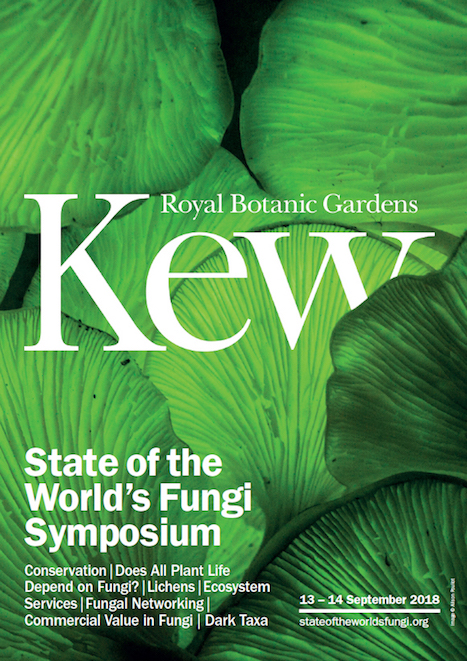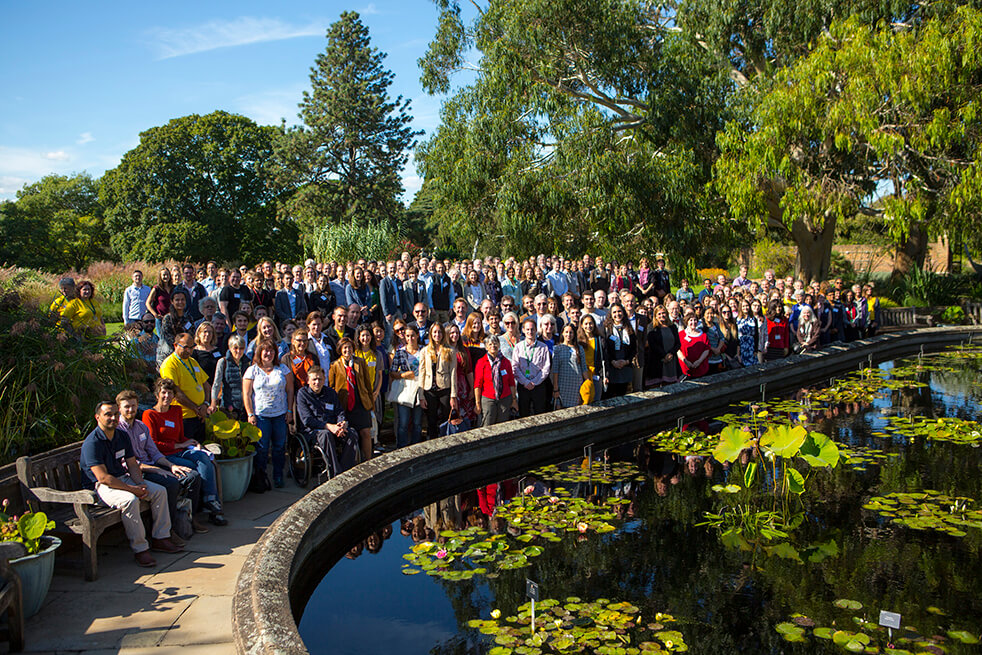Symposium – 13–14 September 2018, Royal Botanic Gardens, Kew, UK. Report by Alison Pouliot
left: Program cover with images of luminous Australian fungus, Omphalotus nidiformis. Cover Design © Royal Botanic Gardens, Kew. Image © Alison Pouliot. right: Participants at the State of the World’s Fungi Symposium, Kew, UK. © Royal Botanic Gardens, Kew / Mark Winwood.
What do dark taxa, quantum dot nanoparticles and hairy earth tongues have in common?
These tantalising subjects were all part of presentations or posters at the State of the World’s Fungisymposium held at Kew Gardens, London from 13–14 September this year.
The symposium coincided with the release of the State of the World’s FungiReport, brought together by numerous authors and edited by Director of Science at Kew, Professor Kathy Willis. The report reviews the current state of fungal knowledge, conservation concerns and major issues affecting fungal diversity among other themes.
Over the years, I’ve greatly enjoyed visiting the world’s only Fungariumto mine its vast specimen collection. On this occasion, as I approached the Jodrell Laboratory (in the shade of that magnificent euc) I was struck by the abundance of Homo sapiens. 263 specimens to be precise! Symposium participants had dispersed from 24 countries across five continents and 128 institutions, to gather for two intensive days of presentations and discussions around all things fungal. As one session chair reminded us, the opening day was also the 249th birthday of Alexander von Humboldt, the first person to describe nature as a web of life and to recognise human-induced climate change.
Kathy Willis opened the symposium and introduced the key themes, based around seven topical questions:
– Conservation of fungi: what, why, where and how?
– Does all plant life depend on fungi?
– And have you forgotten the lichens?
– Do fungi provide a greater ecosystem service or disservice?
– Fungal networking – who benefits?
– Panning for gold in the mould: where do we find commercial value in fungi?
– Exploring the dark taxa: when does a molecular signature become a species?
Having a particular interest in fungal conservation, I was excited that this was the theme of the opening session with four such experts as Anders Dahlberg, Greg Mueller, Giuliana Furci and Beatrice Senn-Irlet. Anders emphasised the importance of collaborations between authorities and landowners, scientists and citizen scientists in collecting, analysing and spreading fungal knowledge in facilitating nature conservation. He reminded us that in Nordic countries, fungi receive the same focus as plants and animals in conservation initiatives and assessments – something for which we must continue to fight in Australia.
Greg reviewed progress with the Global Fungal Red List Initiative, stressing the need to get Conservation Mycology recognised as a discipline of Conservation Biology. It was heartening that Greg acknowledged the international significance of Tom May’s work with Fungimap and the recent co-authored paper (in press in Conservation Biology) led by Tom on Conservation Mycology.
Founder of Chile’s Fundación Fungi, Giuliana Furci is an always-inspiring presenter and reiterated the Foundation’s approach of going straight to the top and persistently lobbying politicians over many years until fungi were incorporated into Chile’s Environmental Law. Giuliana made the point that we don’t have time to wait for complete inventories of data, but considered that there is already enough to catalyse real change at a political level. Her Foundation’s top-down approach stands out in conservation initiatives that more typically work the other way and has also been effective in creating jobs for mycologists.
Beatrice overviewed the current conservation situation in continental Europe and the challenges of meeting the 2030 Aichi Biodiversity Targets. She also spoke of the importance of next generation sequencing for monitoring conservation performance and the rise of new areas such as mycotourism.
There is not room in this brief report to describe all of the presentations but overall the quality of the research and presentations was absolutely exceptional. A recurring theme throughout the symposium was the significance of understanding fungi in the rapidly changing environments of today, in particular in predicting fungal responses to change. The importance of understanding symbioses was also a recurrent theme and the ever enthusiastic Martin Bidartondo opened the second session emphasising how new research is revealing a more distinctive and versatile fungal mutualist repertoire than expected. This followed with an entire session dedicated to those most famous of mutualists, the lichens. Speakers described new research and models being used to explore how distributions and symbioses can help characterise climate change and threats to biodiversity. This also emphasises the need to protect different areas of a species’ range so as to maximise its diversity, allowing it the greatest chance to adapt to stresses and the overarching issue of climate change. However, it also exposes the limitations of slotting lichens into existing models, such as the criteria for evaluating extinction risk, when factors such as generation time are extremely difficult to determine.
The final hour of the first day was a dynamic whirlwind of sixty-seven poster presentations delivered in 45 second time-slots (and not one second more!). The presenters rose to the challenge (and the threat of being gonged off stage) distilling the essence of their research and often incorporating a wonderfully entertaining element of performance. Congratulations to poster prize winners, Tara O’Neill and Samantha Dawson.
The first session of the second day – Do fungi provide a greater ecosystem service or disservice? – had me perplexed. All four speakers gave excellent presentations of their fascinating and cutting edge research. However, I fail to comprehend how this sort of dichotomy suggested in the session title is even vaguely helpful. My concerns were echoed by the familiar voice of David Minter (president and founder of the International Society for Fungal Conservation) piping up from the back of the auditorium, who in his friendly but frank manner rhetorically asked: “Ecosystem disservices, what on earth are you talking about?”. Fungal conservation has endlessly battled against this sort of scapegoating of fungi as the cause of environmental issues, rather than being a symptom of complex systemic problems, usually related to poor agricultural and forestry practices, especially the creation of monocultures. It seems to me that the misnomers of ‘ecosystem services and disservices’ only serve to perpetuate fundamental misunderstanding about fungi and greatly hinder fungal conservation. Other than not making ecological sense, the notion of ‘ecological disservice’ is a disservice to fungi. Perhaps it’s time to move beyond the good fungus – bad fungus binary.
One of the most visually sophisticated presentations of the symposium – combining an astonishing collection of stills and animations – was that of Toby Kiers. Toby examined the evolution of cooperation and dispelled the myth that complex systems of communication, transport and exchange between fungi and plants are harmonious, but rather, underlying the apparent cooperation are conflicts and much can be learnt from these tensions. The role of fungal–bacterial interactions, often under-recognised, was highlighted by the fascinating research of Paola Bonfante. It was also tremendous to see the focus given to the importance of endophytes, especially their role in conferring multiple stress tolerances (e.g. heat, cold, drought, salinity etc.).
The final session – Exploring the dark taxa: when does a molecular signature become a species – was one of the most compelling. Most fungi can be considered ‘dark matter’ because of the enormous gap between described and estimated species diversity (far greater than for animals and plants). The profound disconnect between species discovery and description exposed the challenges of finding a new way forward with taxonomy, given the vast number of taxa revealed in the ‘omics era’ and the race against time.
Overall it was a brilliant conference that ran like clockwork thanks to months of behind-the-scenes preparation and organisation. The excellent session chairs also deserve a special mention. It would have been nice to see more Australian or even austral representation or content, but at least we are glowingly represented on the Program cover!
The State of the World’s Fungi Report can be downloaded here.
The State of the World’s Fungi Symposium Program can be downloaded here.



